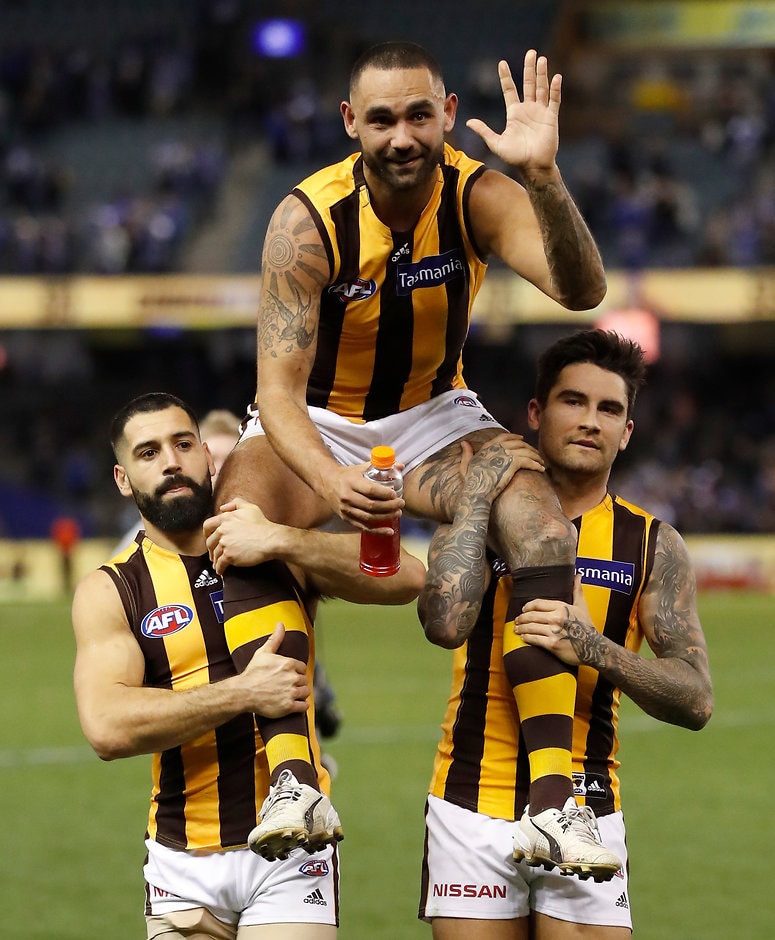HOW LONG is too long after 30?
North Melbourne ruckman Todd Goldstein's freshly minted, three-year contract at age 31 has raised that question again.
AFL TRADE HUB All the latest news
Hawthorn, for example, has a hard-and-fast rule that any player who signs a new deal after their 30th birthday gets no longer than one season at a time.
There weren't even exceptions for the likes of Shaun Burgoyne or Ben Stratton, only months after he was named captain this year.
Shaun Burgoyne signed another one-year deal this week. Picture: AFL Photos
Port Adelaide is another club that appears to operate in a similar vein.
Not every club can get away with such a strict policy – and the Hawks may eventually have to be more flexible, too.
Half of the 18 clubs have at least one recent example of handing a multi-year contract to a player aged 30 or older.
EXAMPLES OF SIGNING MULTI-YEAR DEALS AGED 30 OR OLDER
CLUB | PLAYER | SEASON | AGE AT TIME | YEARS |
Adelaide | Eddie Betts | 2017 | 30 | Three |
Brisbane | Mitch Robinson | 2019 | 30 | Two |
Carlton | Marc Murphy | 2018 | 30 | Two |
Collingwood | Daniel Wells | 2016 | 31 | Three |
Fremantle | Aaron Sandilands | 2015 | 32 | Two |
Geelong | Gary Ablett | 2017 | 33 | Two |
Gold Coast | Jarrod Harbrow | 2019 | 30 | Two |
Melbourne | Jordan Lewis | 2016 | 30 | Three |
North Melbourne | Todd Goldstein | 2019 | 31 | Three |
The remaining clubs almost all have modern cases of committing to key players in their mid-to-late 20s on extended deals that take them well into their 30s.
That includes Essendon (Michael Hurley and Cale Hooker), Greater Western Sydney (Brett Deledio), Richmond (Alex Rance and Jack Riewoldt), St Kilda (Dan Hannebery), Sydney (Lance Franklin and Josh Kennedy) and West Coast (Josh Kennedy and Nic Naitanui).
Goldstein's management, plus rival interest from St Kilda and Geelong, in particular, combined to twist the Kangaroos' arm to the extent 'Goldy' scored a three-year deal.
It is understood their initial offer was just one season, although undoubtedly with some sort of trigger for another year.
They face another challenge in retaining Shaun Higgins in what's a similar situation despite the ex-Bulldog already being contracted through the 2020 season.
Goldstein's been remarkably durable, playing at least 19 senior games every season since 2010.
The only reason he dipped that low in 2017 was because he was dropped to the VFL for a fortnight.
Goldstein's bounced back with a vengeance since, especially this year, when he arguably played as well as any of his campaigns bar his All Australian season in 2015.
There is zero concern about Higgins' form, given he's won the past two North best and fairests and would have been a contender again had he not hurt his AC joint in a tackle.
The silky midfielder, who turns 32 in March, played 20 or more matches in three of his first four seasons at Arden St before managing 17 this year.
What the star Roos pair are doing isn't necessarily an outlier either, with advances in sports science, among other reasons, contributing to footballers' AFL careers lasting longer.
A look at games played in 2019 suggest there should be increasing trust when list management teams weigh up the length of veterans' contracts.
YEAR | MATCHES BY ALL 30+ | MATCHES BY 30+ RUCKMEN |
2002 | 595 | 70 |
2003 | 817 | 43 |
2004 | 672 | 76 |
2005 | 773 | 83 |
2006 | 781 | 81 |
2007 | 973 | 102 |
2008 | 771 | 56 |
2009 | 707 | 104 |
2010 | 635 | 94 |
2011 | 621 | 58 |
2012 | 765 | 75 |
2013 | 884 | 68 |
2014 | 1065 | 91 |
2015 | 1026 | 75 |
2016 | 1038 | 38 |
2017 | 1010 | 60 |
2018 | 972 | 78 |
2019 | 1130 | 121 |
AFL Player Ratings points help provide a gauge on when players in each position peak, although it isn't an exact science, because typically only the best footballers go well beyond age 30.
Midfielders enjoy success the earliest and for the longest, reaching a double-digit Player Rating by age 21 compared to key forwards not doing so until 25.
Key defenders thrive from about 24, whereas ruckmen hit their best rating in their 27th year but power on as long as any position.
Even Hawthorn recognised that this week when it re-signed Jon Ceglar, who turns 29 in February, for the next three years.
There are myriad factors for list managers to consider in contract calls but the statistics overwhelmingly tell us there is life after 30.


